[ad_1]
In 2020, the COVID-19 pandemic hit and everyone was forced to spend time indoors. This is when many of us discovered TikTok; a video sharing app that now has over a billion active users around the world.
Since then, TikTok has become a major force in marketing. Brands pay top influencers millions to access their audiences. A single promotion got Chipotle over 1,000,000,000 views on the platform.
But as big as TikTok is, how does it measure against Instagram – the other social video platform – with its 1.3 billion active users worldwide?
Today, C&C and Will Varney from Megaphone – a top digital marketing agency – give you the answers. We’ll cover each platform’s audience, content type and format, and marketing opportunities.
Let’s start with…
Audiences
TikTok’s audience
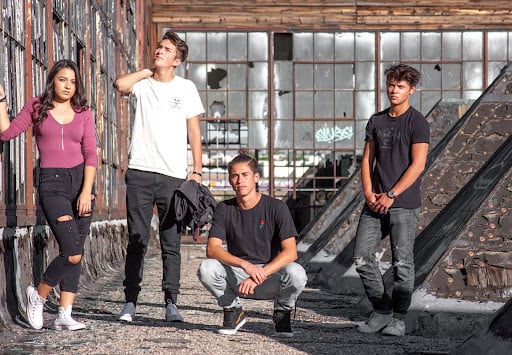
There are many similarities between TikTok and Instagram in terms of user base:
- Both platforms’ ready-to-buy audiences are easy to market to
- Both platforms are mainly used by young people (35 and under)
- Both platforms have a strong presence worldwide
That being said, there are some important differences.
Almost everyone on TikTok is 35 years old or younger. The biggest audience is Gen Z, followed by Millennials, Gen X, and Boomers in that order (source):
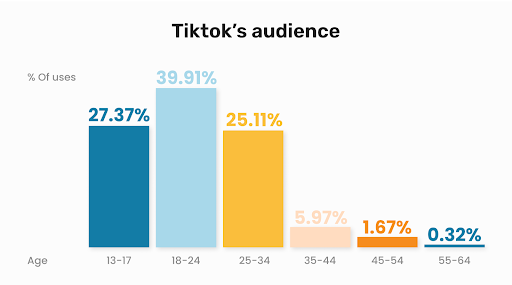
Most of the users are female (57% of users vs 43% male). TikTok is popular worldwide with 135 million users in the US; 99.07 million in Indonesia; 73.58 million in Brazil.
TikTok users tend to be more responsive to advertising. They are also eager to buy and download products aimed at younger people, like:
- Video games
- Inexpensive jewelry, house decor, and makeup
- Novelty products
- Budget cosmetics and perfumes
- Inexpensive ecommerce products
TikTok users respond well to branded content and influencer partnerships. They respond less to obvious advertising. If you do use advertising, make it look native and natural (i.e. not like an ad).
Instagram’s audience

Instagram is heavily favored by Millenials, but also by Gen Zers. The audience can be broken down as follows:
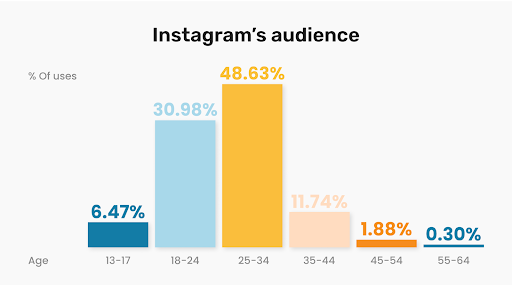
The genders are more evenly split on Instagram; 48.4% of users identify as female and 51.6 identify as male. India had the most Instagram users, with 230.25 million (despite a ban), followed by the United States (159.75 million) and Brazil (119.45 million).
Instagram users are still responsive to advertising, but a little less so than TikTokers. They are more interested in products aimed at both genders of slightly older millennials, e.g.:
- More expensive jewelry
- Infoproducts for professionals and business owners
- Furniture and clothing
- Mid-range artwork, house decor, ecommerce products
- Premium ecommerce products, e.g. health products and make-up
Instagram’s audience responds well to ads and influencer partnerships. Your own content is less likely to be seen on the platform, although it can still be a good asset.
Content Formats
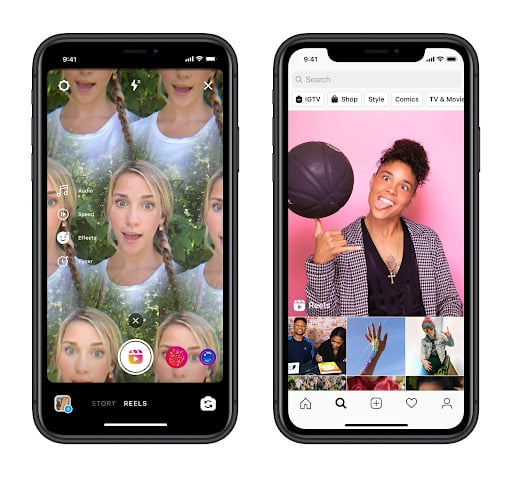
Instagram lets you create content in a variety of formats, including:
- Photos
- Short feed videos
- Instagram Reels (similar to TikTok)
- Instagram Stories
- Live streaming
- Long-form video content on IGTV
Instagram’s feed looks like most social media platforms, with endless scrolling. It’s easy to go from one post to the next without focusing on any of them. The content formats that work best for ads are Reels – Instagram’s answer to TikTok – and Stories.
TikTok lets users create and upload vertical videos that are up to 10 minutes long. That’s it. Instead of scrolling, you swipe up to move to the next video. Because of this, users are more likely to pay attention to and watch the whole thing (and ads).
Instagram gives you more content formats to work with. This is nice, but it can also make things confusing. Managing ads and content across Photos, Reels, Stories, etc gets complicated – and doesn’t always come with a good return on ad spend (ROAS).
TikTok has a very attractive ROAS… And with just one content format, it’s a lot easier to figure out. The best posting times, content themes, etc., are all a lot easier for TikTok marketers to optimize.
Content Types
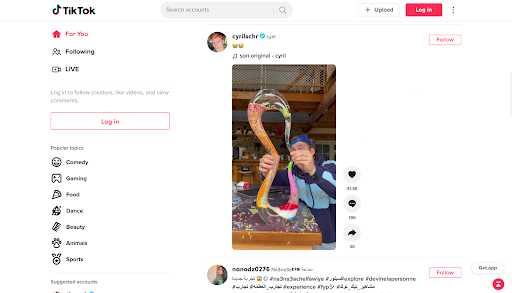
Content shared on Instagram tends to be highly edited, with various filters and effects applied in order to enhance their appearance.
Many users curate their accounts in such a way that all their photos have the same aesthetic and feel. When you visit their profile page, you can quickly get a sense of their style and who they are as a person.
The videos posted on TikTok tend to be much more raw, lo fi, unedited. There are filters that can be used, but many times people will shoot a quick video and upload it instantly. When you visit their profile page, it’s harder to get a sense of their overall aesthetic.
The type of content that gets posted on Instagram and TikTok can differ as well. With Instagram, the focus tends to be just as much about the look and feel of content as it is about the subject matter itself.
With TikTok, the focus is very heavily on the subject matter of the videos. Creators film themselves doing dances, lip syncing, performing challenges, and more. The look and feel of the videos matter, but not nearly as much as what’s happening.
The above makes Instagram a strong choice for carefully designed ads. They blend in with Instagram’s native content.
TikTok is a better choice for influencer partnerships, native-looking ads, and your own content.
Advertising
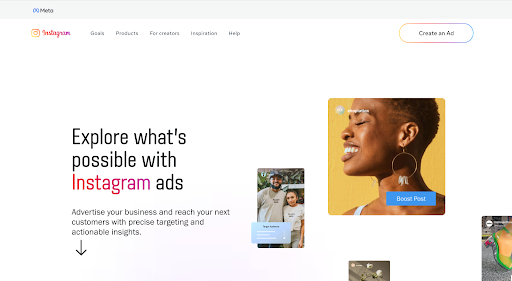
Both Instagram and TikTok allow brands to advertise on their platforms. Instagram allows brands to place both photo and video ads. They can be seen by the target audience in the newsfeed, stories, IGTV, and more.
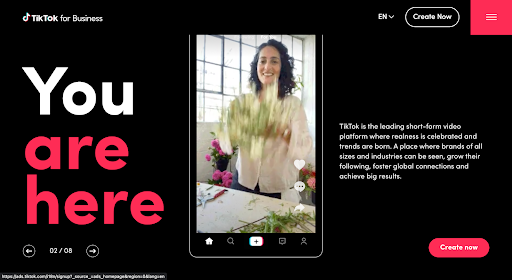
TikTok allows brands to place video ads up to 60 seconds long. They can be seen by the target audience in between other videos, and look almost identical to organic TikTok posts.
Interestingly, when TikTok ads were compared against Instagram Reels ads, Reels outperformed TikTok by quite a bit. The reach was significantly greater, CPC was lower, and CPM was lower (stats).
I attribute some of this difference to people not knowing how to use TikTok quite as well as Instagram. Overall, both platforms work well – although Story and Reel ads work best on Instagram. Experiment to see how you can make the most use of both IG and TT.
Organic Content

When it comes to organic content creation, TikTok is better for reaching a young audience. More than half of users are under the age of 24, and they love organic content.
The TikTok algorithm also rewards users who produce a significant amount of content. If you struggle with creating content, services like TrendFM can help you create more of it for the platform.
The Instagram algorithm rewards users who create less content but make it exceptionally high-quality. The more engagement a piece of content receives, the more exposure it receives on Instagram.
If you want to focus more on quality and less on quantity, Instagram may be the way to go for you. This makes it a good choice for B2B brands, busy marketers, etc.
Influencer Partnerships
If you want to partner with influencers, you should know the difference between Instagram influencer marketing and TikTok influencer marketing.
As we noted earlier, Instagram content tends to be more polished than TikTok content. If your brand has a particularly polished aesthetic, Instagram may be the best choice for you.
If you want sponsored content that is more raw and potentially authentic, consider TikTok.
TikTok is also particularly good for creating brand challenges. If you can develop a creative, engaging challenge for users around your brand, you can connect with a wide audience.
Final Thoughts
Both Instagram and TikTok present unique marketing opportunities for businesses. It’s important to understand the differences between the two platforms so that you can make an informed decision about which one is right for you.
- Instagram is better for polished content, while TikTok is better for raw, authentic content.
- If you want to reach a younger audience, consider TikTok.
- If you’re looking to partner with influencers, both platforms can be effective but Instagram may give you more polished options.
Finally, don’t forget to test each platform for yourself to see which one works better for your business. There’s no magic answer for which platform is better.
About the Author
Will Varney is a strategist at Megaphone Marketing: an 8-figure agency with offices in Australia, the US, and the UK. He’s passionate about ecommerce, social media marketing, and new channels like TikTok and Instagram
[ad_2]
Source link









